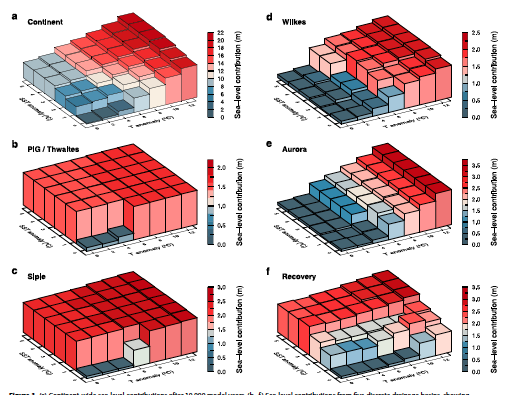The Recovery drainage basin in the eastern Weddell Sea will more likely be the first contributor of future ice loss from EAIS due to ocean warming.
Geophysical Research Letters by Golledge et al.
Antarctica is an important contributor to sea level rise; hence, it is critical to estimate the response of the ice sheet to oceanic and atmospheric warming. If emissions of greenhouse gases continue unchanged, Antarctic ice sheets have the potential to contribute between 0.4 - 0.8 m of sea-level rise by 2100 and more than 10-15 m by 2500 (Golledge et al., 2015; De Conto and Pollard, 2016). In this study, Nick Golledge and his team used a three-dimensional ice-sheet model to simulate the response of the ice (sheet, stream and shelf) flow across the Antarctic continent, which enables spatially-variable ice sheet responses to be compared with each other. Because considerable uncertainty remains in projections of future ice loss from East Antarctic Ice Sheet (EAIS) due to its complex estimation, the main objective of the group was to describe and simulate the responses and mass loss patterns of three East Antarctic drainage basins, or catchments. Due to its implications for coastal cities around the world, reducing the uncertainty of ice loss and hence sea level projections is a social priority.
The climatology simulations run in this study show: (i) the dependency of both East and West Antarctic ice sheets on environmental conditions; (ii) the linear increase of ice loss with increasing oceanic and atmospheric temperatures at a continental scale; (iii) the different sectoral behaviors between WAIS and EAIS catchments, the former showing an abrupt sensitivity to ocean temperatures; (iv) the delicate threshold for stability of WAIS that with an ocean warming of only 0.5°C applied over many millennia can lead to the loss of the most of the marine-based ice in this sector; and (v) Recovery drainage basin as the more sensitive catchment to ocean warming and the likely major contributor of ice loss from EAIS. This study discusses the implications of the future freshwater fluxes from ice melt of the Recovery drainage basin, which can significantly disrupt the Antarctic bottom water (AABW) formation. Previous simulations from the same group have shown that this mechanism could trigger a positive feedback that accelerates the grounding retreat (Golledge et al., 2014) and has global climatic consequences (Bakker et al., 2016).

Figure 1. Sea level response pattern for five of the largest Antarctic catchments and continent for sea-water and air temperature combination (a) Continent-wide sea-level contributions after 10,000 model years. (b–f) Sea-level contributions from five discrete drainage basins, showing considerable differences in environmental sensitivity and nature of threshold response under warmer-than-present air (T) and ocean (SST) temperatures. The Pine Island Glacier (PIG)/Thwaites Glacier and Siple Coast catchments of West Antarctica (Figures 1b and 1c) exhibit high sensitivity to relatively modest warming values; Wilkes (Figure 1d) and Aurora (Figure 1e) catchments exhibit a threshold sensitivity to air temperature, but not ocean temperature; Recovery basin (Figure 1f) exhibits an abrupt response to ocean temperature but is less sensitive to air temperature.
Bakker, P., P. U. Clark, N. R. Golledge, A. Schmittner, and M. E. Weber (2016), Centennial-scale Holocene climate variations amplified by Antarctic ice sheet discharge, Nature, 541, 72–76, doi:10.1038/nature20582.
DeConto, R., and D. Pollard (2016), Contribution of Antarctica to past and future sea-level rise, Nature, 531, 591–597.
Golledge, N., L. Menviel, L. Carter, C. Fogwill, M. England, G. Cortese, and R. Levy (2014), Antarctic contribution to meltwater pulse 1A from reduced Southern Ocean overturning, Nat. Commun., 5, 1–10, doi:10.1038/ncomms6107.
Golledge, N., D. Kowalewski, T. Naish, R. Levy, C. Fogwill, and E. Gasson (2015), The multi-millennial Antarctic commitment to future sea-level rise, Nature, 526, 421–425.
Golledge, N. R., R. H. Levy, R. M. McKay, and T. R. Naish (2017), East Antarctic ice sheet most vulnerable to Weddell Sea warming, Geophys. Res. Lett., 44, doi:10.1002/2016GL072422.
Full article at: http://onlinelibrary.wiley.com/doi/10.1002/2016GL072422/full
EOS spotlight article: https://eos.org/research-spotlights/what-regions-are-most-at-risk-for-ice-loss-in-east-antarctica
PS


